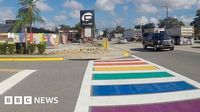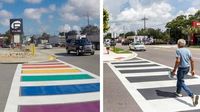In the quiet hours before dawn on August 21, 2025, a team from the Florida Department of Transportation (FDOT) arrived at Orlando’s Pulse nightclub memorial. Their mission: to erase the rainbow crosswalk that, for nearly eight years, had stretched across West Esther Street—a symbol of resilience, remembrance, and pride for the LGBTQ+ community and the city at large. By sunrise, the vibrant stripes were gone, replaced by the stark black-and-white lines of a standard pedestrian crossing. The act, done without warning or public notice, has sparked outrage, heartbreak, and a wave of protest across Florida and beyond.
The crosswalk had stood since 2017, a year after the tragic mass shooting at Pulse nightclub claimed 49 lives and wounded 53 others. The massacre marked one of the deadliest attacks on LGBTQ+ people in U.S. history. The rainbow crosswalk, installed with state approval at the time, quickly became a sacred site—a visual promise that Orlando would never forget those lost and would continue to fight for equality and inclusion. As reported by Florida Politics, the crosswalk was more than just paint on pavement; it was a tribute, a rallying point, and a symbol of hope for a community scarred by violence.
Orlando Mayor Buddy Dyer, in a statement released the morning after the removal, expressed devastation and anger. “We are devastated to learn that overnight the state painted over the Pulse Memorial crosswalk on Orange Avenue. This callous action of hastily removing part of a memorial to what was at the time our nation’s largest mass shooting, without any supporting safety data or discussion, is a cruel political act,” Dyer said, as quoted by The Advocate. He emphasized that the crosswalk had been installed by the state and adhered to national safety standards, serving both as a safety measure and as a living memorial. “While the state works to erase the memory of the victims of the Pulse tragedy by painting over the crosswalk, our community’s commitment to honoring the 49, and completing the memorial, will never waver,” Dyer added.
The removal was not just sudden—it was secretive. City officials, including Mayor Dyer and state Rep. Anna V. Eskamani, said they received no warning or directive from FDOT prior to the action. “Then, apparently, in the middle of the night, FDOT painted over it, with no notice, no warning, and did not tell the city. We only found out this morning because there was no more crosswalk there. It’s so incredibly shameful. Doing it in the middle of the night emphasizes that you’re trying to hide your bigotry,” Eskamani told The Advocate. She also noted that the crosswalk had been previously approved by the state and that research shows colorful crosswalks can actually improve pedestrian safety.
For many, the timing and method of the removal felt like a deliberate affront. Florida state Sen. Carlos Guillermo Smith, the first out gay Latino elected to the Florida Legislature, recorded a video message at the site on Thursday morning, standing before the freshly painted crosswalk. “We just discovered that the Florida Department of Transportation, in the middle of the night, ripped the rainbow colors off of this city crosswalk. They illegally vandalized city property without providing the City of Orlando notice or getting their approval,” Smith said, according to The Advocate. He did not mince words: “I cannot believe that the DeSantis administration has engaged in this hostile act against the city of Orlando, that they have insulted the families and survivors of this horrific tragedy, and that they have done this in this way. Of course, they did this in the middle of the night because they knew what they were doing was wrong. I hope the City of Orlando paints these colors back onto their property and that they sue the state of Florida.”
Florida Governor Ron DeSantis responded to the mounting criticism by framing the action as part of a broader effort to keep state roads free from what he termed “political purposes.” “We will not allow our state roads to be commandeered for political purposes,” DeSantis stated, as reported by The Hill. This stance is consistent with recent moves by his administration. In June, DeSantis omitted references to LGBTQ and Hispanic people—communities disproportionately affected by the Pulse shooting—in the annual order honoring the tragedy’s victims, a marked change from previous years. The omission and the removal of the crosswalk have been interpreted by many as part of a pattern of erasure and marginalization.
The FDOT, for its part, has cited safety and compliance as its rationale. Michael Williams, the department’s communications director, explained that a recent review of all state-maintained roadways led to the correction of pavement markings not in compliance, including the Pulse Memorial’s rainbow crosswalk. “Transportation infrastructure is for the movement of people and goods. In this case, while the crosswalk has been restored to its proper form, local efforts are underway to construct a permanent memorial on adjacent properties funded by the State of Florida. Any attempt to suggest otherwise is false,” Williams told The Hill. An earlier memo from Will Watts, an FDOT assistant secretary, stated that “surface art” not directly contributing to traffic safety “can lead to distractions or misunderstandings, jeopardizing both driver and pedestrian safety.”
Yet, advocates and local officials push back against the safety argument. Orlando’s crosswalks, including the one at Pulse, were installed in close coordination with the state and adhere to national safety standards, according to Mayor Dyer. Rep. Eskamani emphasized, “We did everything according to state law, everything was compliant. FDOT never moves that quickly with anything.”
The removal is not an isolated event. As The Advocate and Florida Politics report, FDOT has warned other Florida cities—such as Delray Beach and Key West—to remove their rainbow crosswalks by September 3, 2025, or face similar action. The move also echoes a national trend. In July, U.S. Transportation Secretary Sean Duffy, under the Trump administration, instructed governors to remove “political messages or artwork” from crosswalks, arguing that “roads are for safety, not political messages or artwork.”
The backlash has been immediate and intense. Brandon Wolf, a survivor of the Pulse shooting and national press secretary for the Human Rights Campaign, wrote, “In the dark of night, they came to erase our show of solidarity, our declaration that we will never forget. The cowards who feel threatened by our lives should feel lucky they didn’t have to bury the ones they love — then watch the state come & desecrate their memory.” Equality Florida, a leading LGBTQ rights group, called for a peaceful gathering at the Pulse Memorial and encouraged Floridians to display rainbow symbols in a show of unity and resistance. Executive director Nadine Smith stated, “We have endured decades of state-sanctioned discrimination. And, like every attack before it, this act is designed to spread fear, dispirit us, and push us back into the shadows. But just as we did in the hours after Pulse, our community will come together, look out for each other, and raise our flags higher. We refuse to be erased. We will not let hate win.”
As Orlando moves forward with plans for a permanent memorial at the Pulse site, the controversy over the crosswalk underscores the ongoing struggle over public memory, visibility, and the meaning of community in the face of tragedy and political division. The rainbow may have been painted over, but the commitment to honor the 49 lives lost at Pulse—and to fight for equality—remains as strong as ever.

